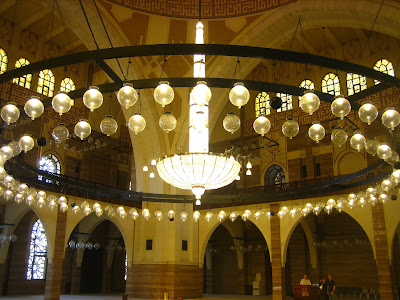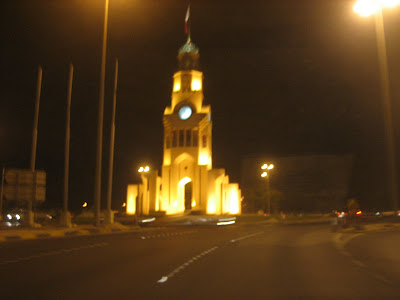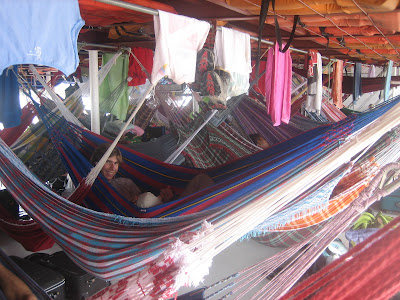

"Work as if you will live for ever; live as if you will die tomorrow."
I took a tour of the Grand Mosque here in Manama, Bahrain today. I have to say, the tour was much more than I had hoped for. The mosque is quite a sight from the outside...much different than the "mosque" we had back at my little base in Afghanistan, where we set aside a small room in a mud brick hovel as a mosque. I had heard the mosque was open to tourists, but not quite believing that I was a little apprehensive upon approach, having always thought mosques were off limits to unbelievers. I went on up into the mosque area though, and was nearly immediately approached by a woman dressed in the black covering that all the local women around here wear, asking me in flawless English if I would like a free tour of the mosque. I said I would; we took off our shoes and off we went.
She was clearly quite a devotee to her job and her religion, and proceeded to give me a very thorough and professional tour of the inside of the mosque. I learned or was reminded of quite a few facts about Islam and mosques...and it's true that most all mosques are closed to non-Muslims. The Grand Mosque seemed more of a showpiece than a real congregation though...the kind of place Muslims might go on special occasions, but not for their daily prayers. Perhaps for that reason it's open to tourists.
In any case, I was struck by the simplicity of the mosque. Though the structure itself, with its massive dome and high minarets is certainly very majestic, inside the mosque is mostly empty. I knew ahead of time that mosques aren't filled with adornments like many churches are, but nevertheless seeing such a grand structure mostly empty but for the admittedly gaudy chandeliers and some Arabic calligraphy (this Arabic calligraphy being straight lines, since their regular letters are curvy and flowing as we would think of calligraphy in English) on the walls was a reminder to me of the focus on Allah that Islam preaches. I've always been appreciative of simplicity and detested needless complexity (I can recall being chastised by my boss in a law firm "continually over-simplifying the issues"...perhaps all of this explains why I'm not a lawyer...?), and I come to appreciate simplicity more and more every day in an increasingly complex world. At any rate, the lack of distraction in the mosque itself encourages its adherents to focus on their prayers. That, and the togetherness the prayer ritual itself engenders (which I was allowed to witness, happening to be there during one of the five daily prayer times), by having the devotees line up with shoulders touching the persons on either side as they go through their prayer ritual, were the aspects of the experience that affected me the most. It's not hard to see Islam's appeal, for the simple authenticity and community inherent in it.
My guide, truly the consummate professional, refrained from outright trying to convert me to Islam, but I would not be surprised if she had people walking out of the mosque after a tour with her considering it. Every explanation made so much sense...women are covered because this helps men see them as equals...men not being distracted this way by the physical aspects of a woman, they can now focus on who she is.... Interestingly, apparently even Islam has found the need to substantiate its authenticity in a "scientific" way, my guide mentioning to me a couple of scientific facts which were revealed to Mohammad and which he would have had no way of knowing in the 7th century that were subsequently placed in the Quran. I also noticed a pamphlet on the scientific basis of Islam in the library on my way out...one of many free pamphlets visitors are encouraged to take with them.
All in all, the mosque visit provided a nice counterbalance to some of the negative impressions/thoughts I have had over the years about Middle Eastern and Afghan culture, much of which I have attributed to the religion that is so interwoven with it.








































